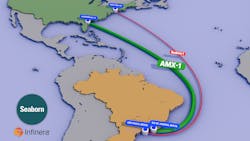Seaborn launches services on AMX-1 submarine network with Infinera
Seaborn Networks says it is now offering services on its AMX-1 submarine network that connects Brazil and the U.S. AMX-1 complements Seaborn’s existing submarine cable, Seabras-1 – and, like Seabras-1, is built on optical transmission systems from Infinera (NASDAQ: INFN).
AMX-1, which runs from Rio de Janeiro to Jacksonville, FL, offers path redundancy for Seabras-1, which extends between São Paulo and New York, according to Seaborn COO Andy Bax. Bax tells Lightwave that some customers of Seabras-1 have opted for redundant capacity on AMX-1 for route protection already. Seaborn operates protected terrestrial routes between São Paulo and Rio as well as up and down the U.S. East Coast to enable customers to use the two systems for path redundancy.
A notable architectural feature of AMX-1 is its express routing of capacity through the cable landing stations and straight to the point of presence (PoP). The approach provides efficient delivery of transport, Ethernet private line, and IP services over 100-Gbps coherent wavelengths, says Bax. The system has proven so popular that Seaborn already has an upgrade in the works that will double its system capacity to more than 1 Tbps.
Seaborn uses Infinera equipment for both its terrestrial and submarine cable requirements. Seabras-1 leverages elements of the 3300 and 3600 families within Infinera’s XT Series (see “Seabras-1 submarine network operational with Infinera XTS-3300 meshponders”), while AMX-1 currently uses the 3300 line. Bax says deployment of 3600 platforms are planned for early next year. Both systems use Infinera’s ICE4 coherent engine (see "Infinera moves terabit optical networks closer to commercialization with Infinite Capacity Engine” and "Infinera offers SLTE based on Infinite Capacity Engine"). Bax says the company plans to add ICE6 capabilities at some point after the newest version of Infinera’s Infinite Capacity Engine becomes available later this year (see “Infinera unveils ICE6 coherent engine, Infinite Network vision”).
Opening AMX-1 for business is one of several steps Seaborn plans to take to serve the Americas. Bax earlier told Lightwave that the company plans an extension of Seabras-1 into northern Brazil as well as additional infrastructure that would offer connectivity to Central America (see “Revamped Seaborn plots slightly altered submarine network course”). Those plans remain on track, he says.
For related articles, visit the Network Design Topic Center.
For more information on high-speed transmission systems and suppliers, visit the Lightwave Buyer’s Guide.
To stay abreast of fiber network deployments, subscribe to Lightwave’s Service Providers and Datacom/Data Center newsletters.
About the Author

Stephen Hardy
Editorial Director and Associate Publisher, Lightwave
Stephen Hardy is editorial director and associate publisher of Lightwave and Broadband Technology Report, part of the Lighting & Technology Group at Endeavor Business Media. Stephen is responsible for establishing and executing editorial strategy across the both brands’ websites, email newsletters, events, and other information products. He has covered the fiber-optics space for more than 20 years, and communications and technology for more than 35 years. During his tenure, Lightwave has received awards from Folio: and the American Society of Business Press Editors (ASBPE) for editorial excellence. Prior to joining Lightwave in 1997, Stephen worked for Telecommunications magazine and the Journal of Electronic Defense.
Stephen has moderated panels at numerous events, including the Optica Executive Forum, ECOC, and SCTE Cable-Tec Expo. He also is program director for the Lightwave Innovation Reviews and the Diamond Technology Reviews.
He has written numerous articles in all aspects of optical communications and fiber-optic networks, including fiber to the home (FTTH), PON, optical components, DWDM, fiber cables, packet optical transport, optical transceivers, lasers, fiber optic testing, and more.
You can connect with Stephen on LinkedIn as well as Twitter.
